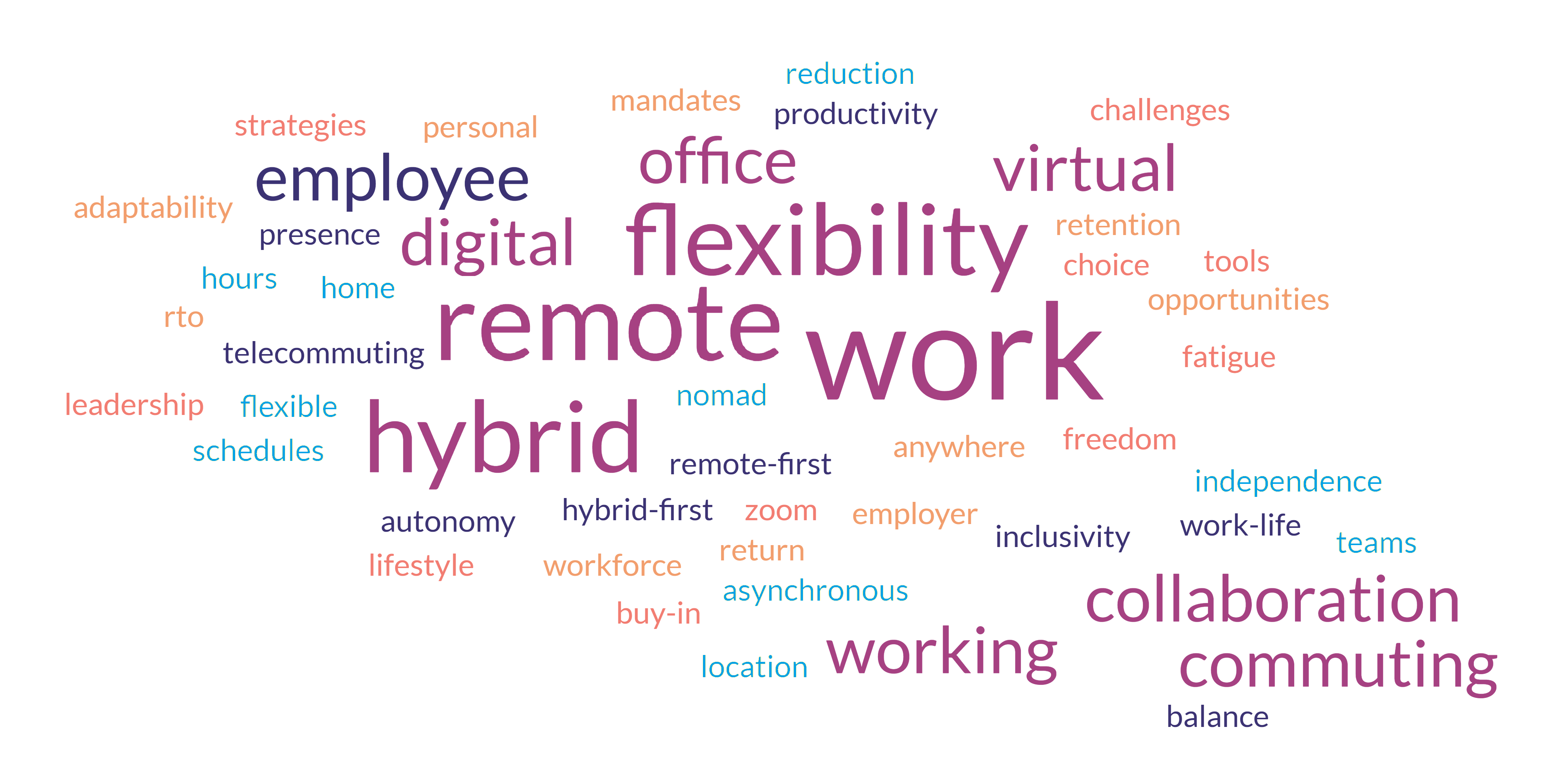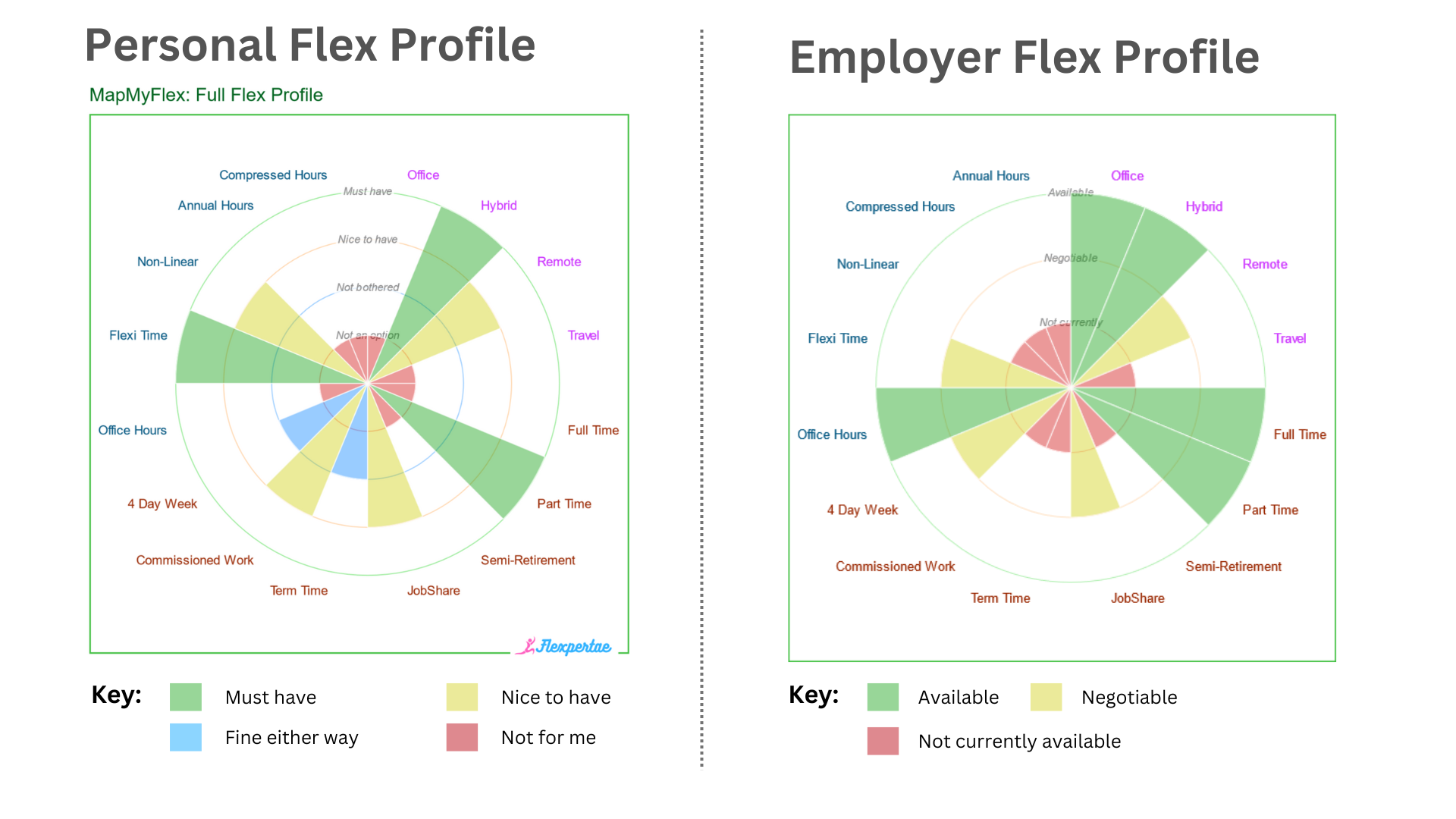
Has Remote Working Hijacked The Flexible Working Narrative ?
By now, you've likely heard of flexible working, along with terms like remote and hybrid.
It's a recurring topic in news headlines, studies, surveys, and social media - the ongoing battleground of office vs. remote work, often discussed as if it's a binary choice, black or white, rather than a multi-faceted issue deserving of a deeper, more meaningful, conversation.
The pandemic catalysed a monumental shift in work culture; overnight remote working shifted from a niche option to a mainstream necessity. Companies scrambled to enable employees to work from home, and this transformation was widely celebrated for its ability to maintain productivity while safeguarding public health. However, as remote working gained traction and widespread adoption, the broader concept of flexible working began to take a back seat.
Which leads me to the question – has this shift had unintended and undesired consequences,
particularly for individuals who rely on flexible working arrangements not as a lifestyle choice but as
a necessity to remain in, or return to, the workforce?
The Pandemic and the Rise of Remote Working
Let's cast our minds back to 2020 when remote working was rapidly adopted during the COVID-19 outbreak, with more than 50% of the workforce in many countries working from home by mid-2020. Initially it was seen as a temporary adjustment to ensure business continuity, and then as people started experiencing the benefits of remote work first hand, they found they liked it. It became normalised in many sectors, particularly in tech, finance, and creative industries.
For a vast number of people remote work was a revelation, offering better work-life balance, reduced commuting time, space for deep thought work, and cost savings. By 2022, remote or hybrid work became a standard expectation for millions of people.
Specialist job sites advocating flexible working and mostly remote jobs sprung up in greater numbers. Recruiters found a correlation between remote or hybrid job ads and a greater number of applications. Suddenly employers added flexible working to their job specs, however tenuous the flex offered was. Increasingly flexible working was seen to mean remote or hybrid working.
Flexible Working vs. Remote Working
While remote work is a form of flexible working, the two are not synonymous and you’d, maybe, be forgiven for thinking otherwise given the equivalence seen across discussions. Flexible working encompasses a wide array of arrangements, such as:
- Flexible hours (flexi-time): Allowing employees to set start and end times around personal
needs.
- Part-time work: Reducing hours to accommodate caregiving or health requirements.
- Compressed workweeks: Working longer hours on fewer days.
- Job sharing: Two employees sharing the responsibilities of one role.
- Shift work: Accommodating those who need non-traditional hours.
- Nonlinear hours: Working asynchronously and completing tasks in flexible, focused bursts
throughout the day.
- The 4-day week: Reducing the work week to four days instead of five which has run a number
of successful trials.
- Term-time working: Working regular hours and days during term time, with flexibility during school holidays.
However, the pandemic-era discourse and beyond increasingly equated flexible working with remote working, overshadowing other crucial forms of flexibility. This conflation has particularly disadvantaged demographics who require tailored arrangements to remain employed. Transforming the legitimate essential needs of disadvantaged groups into an ongoing debate on work-lifestyle choices and privilege has detracted not only the serious aspects of the flex conversation but also diverted the spotlight away.
The Pandemic and the Rise of Remote Working
- Carers: Over 5 million UK workers juggle employment with caregiving responsibilities. They
often require flexible hours or part-time roles,
not necessarily remote work.
- Working mothers: Many need flexible schedules to balance childcare, particularly in the
absence of extended family support and challenging
childcare conditions.
- People with disabilities or chronic illnesses: Flexible work arrangements allow these
employees to manage health conditions and medical appointments.
The employment rate for people with disabilities is already shockingly low compared to their
non-disabled counterparts.
- Parents of children with special educational needs (SEN): Flexibility enables them to
address their children’s unique care or schooling needs, reducing
their stress and worry.
- Neurodiverse individuals: May thrive with tailored hours or job-sharing opportunities that
reduce overstimulation or fatigue.
- People with long term health issues: Around 9.4m people, approx. 36% of the working age population have at least one long-term health issue. Among these 18% of working age people have reported condition that limit their work. The major health issues are musculoskeletal, chronic illnesses, complex multiple co-existing conditions, and mental health conditions.
The Backlash: RTO Mandates and Their Impact
In 2024 especially many companies issued Return-to-Office (RTO) mandates, claiming the need for collaboration, innovation, and cultural cohesion. Some speculate that they used these mandates to reduce headcounts without layoffs, as not all employees could return due to caregiving responsibilities or health limitations, whilst others simply don’t want to relinquish their new-found work-life balance.
Among these companies perhaps the most prominent are Amazon and Google who introduced RTO policies that likely disproportionately impacted parents and carers, as on-site demands clashed with their caregiving roles. Meta laid off employees who had heavily invested in remote roles, framing the shift as a cultural reset.
These policies often overlooked employees for whom remote working was a necessity. The conflation of flexible working with remote working has meant that other critical forms of flexibility, like adjusted hours or job-sharing, were sidelined in the discourse potentially making it harder for marginalised groups to negotiate their needs.

Has Remote Work Hijacked Flexible Work?
Remote working coverage across media and social media accounts for approximately 75-80% of all flexible working discussions and articles. This includes various models like fully remote, work-from-anywhere policies, and telecommuting.
Of the remaining 20-25% of discussions focusing on non-remote flexible working, flexible hours (e.g., staggered starts or compressed weeks) and part-time arrangements receive the most attention, followed by job sharing and term-time-only roles.
Clearly the debate over flexible working has been dominated by remote work enthusiasts, mostly professionals in white-collar roles who advocate for lifestyle benefits. While these preferences are valid, they have risked diluting the conversation about the essential nature of flexible working for marginalised demographics.
When flexible working is reduced to a "perk" for convenience, employers can end up deprioritising the structural changes needed to support those for whom it is critical. This then loses the company existing and new talent, not to mention the reputational cost. Instead, adopting a more comprehensive approach to flexibility can enhance engagement, improve productivity, and attract top-tier and diverse talent.
Moving Forward: Reframing the Conversation
To protect and expand flexible working, employers, policymakers, and advocates must:
- Recognise diverse needs: Flexible working should serve a spectrum of employees, not just
those who prefer remote work.
- Promote inclusivity: Flexible work policies must accommodate the specific needs of carers,
parents, disabled, and other under-represented employees.
- Educate on options: Employers should distinguish between remote work and other forms of
flexibility, offering solutions tailored to individual circumstances.
- Mandate flexibility: Governments could introduce legal protections ensuring access to
flexible arrangements for those with caregiving or health needs, notably the UK introduced a bill this
year making flexible working a day 1 ask as a positive step forward.
- Understand necessity vs choice: Distinguish at an individual level between which flexible
working models are “must haves” vs “nice to haves” for each person. What is a showstopper and what is
a perk.
- Acknowledge the transient side of flexible schedules: A person’s flexible working needs and
preferences are not fixed for life, they change as we move through different phases of life, and
employers should recognise that a person’s flexible working profile is a living profile which evolves
and adapts.
At Flexpertae, we introduced the idea of flexible working profiles as part of Flexible Working Day 2024 in the form of MapMyFlex, a free tool which creates visual charts for both employer and employee, displaying what is negotiable, required or a nice to have.

When we understand what is a necessity and what is negotiable on both sides then the conversation between employer and employee can lead to mutually agreed ways of working, tailored for both the individual and the business.
If it’s productivity businesses truly value, then working with their employees to tailor effective flexible working solutions will be a priority. These solutions can be at a companywide, team or individual level.
With flex there is no “one size fits all”.
The rise of remote working has brought undeniable benefits including shining a light on the topic of flexible working, yet its dominance risks overshadowing the diverse needs of marginalised groups.
As we continue to discuss the future of work, isn't it time to shift the narrative back from focusing solely on remote work to exploring the full spectrum of flexible working arrangements that can truly accommodate diverse needs and foster inclusivity?
Blog article by: Zahida Posted: March 2025
(First published on LinkedIn on 12th December 2024)